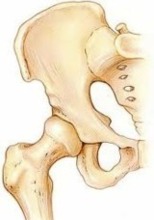|
Acetabulam is one of the vital bone structures of human body and plays an important role in normal body movements. It is located near the hips and acts as a link between three different bones of hips. It is a part of the pelvis and is concave-shaped in appearance. It is also known as the surface area of pelvis and primarily forms the hip socket.
Structure of Acetabulam
The organ is formed by combination of three different bones of the hip bone area. Ischium is covers the back and lower part of the hip bone and also provides side and lower boundaries to the acetabulam. It covers almost the two-fifth part of the acetabular area. Ilium is the largest and uppermost bone of the pelvis and covers another two-fifth of the acetabular area. It is present on the upper side. Pubis forms the rest of acetabular area and is covered by fat layer. It is located near the midline.
Acetabulam and Fractures
 Acetabular fracture is one of the most common disorders occurring in the acetabular areas and may occur in almost any age. Young people may suffer from the fracture due to high-energy trauma (falls, collisions, etc) or due to any other form of injury and impact to the hip areas. Such health issues may create severe problems in normal hip movements and make it difficult for the person to roam freely. Thus, proper diagnosis and treatment of the bone disorder is extremely necessary to prevent the bone from weakening further. Acetabular fracture is one of the most common disorders occurring in the acetabular areas and may occur in almost any age. Young people may suffer from the fracture due to high-energy trauma (falls, collisions, etc) or due to any other form of injury and impact to the hip areas. Such health issues may create severe problems in normal hip movements and make it difficult for the person to roam freely. Thus, proper diagnosis and treatment of the bone disorder is extremely necessary to prevent the bone from weakening further.
Elder people are also prone to acetabular fracture but the causes are quite different as compared to young people. Osteoporosis, a disease causing weakening of bones, and is the main reason for development of acetabular fracture in old people. Main reason for weakening of bones is a considerable decrease in the bone mineral density.
Types of Acetabular Fractures
Both-column fracture is one of the common acetabular fractures. It includes both posterior and anterior columns and also extends to iliac wing and obturator ring.
T-shaped fracture is quite similar to both-column fracture as it also affects the obturator ring. The fracture also affects the ilioischial and iliopectineal lines but does not disturb the iliac wing.
Transverse fracture is another major form of acetabular fracture and is limited only to the acetabulam. It does not impact the obturator ring but involves the posterior and anterior aspects of the acetabular region.
Another form of acetabular fracture is the transverse with posterior wall fracture. It is a combination of transverse fracture and posterior wall fracture and excludes both T-shaped and both-column fractures. Transverse with posterior wall fracture does not reach the iliac wing.
Isolated posterior wall fracture is a major form of acetabular fracture accounting to more than 27% of the overall cases. This type of fracture doesn't have a full transverse acetabular component.
Acetabular fractures can be identified easily by examining the disruption of obturator ring. Fracture in the ring is an indication of both-column or T-shaped fracture. Again, the both-column type of fracture can be differentiated from the T-shaped one by involvement of iliac wing. In the transverse, transverse with posterior wall and isolated posterior wall fracture, the obturator ring remains untouched.
Disruption of ilioischial as well as iliopectineal lines is a good indication of transverse fracture. 3D surface rendering and multiplanar reconstruction along with CT is very helpful in identifying such fracture.
Treatment for acetabular fracture depends on the intensity of hip instability and cartilage displacement. Surgery is the most suited option for restoring stability in the hips and preventing cartilage displacement. In the normal conditions, the hip joint has to be stable (along with the ball held firmly in the socket) and the cartilage must be contoured well. Surgery can be helpful in the alignment of the surface of cartilage, bringing back the hip stability and taking out the debris from the joint of hips.
Acetabulam needs to be carefully examined on regular basis to trace for any bone abnormalities. Patients suffering from acetabular fractures are quite prone to head, urologic, abdominal and musculoskeletal injuries and may develop blood clots in the pelvis or legs. Hip arthritis is another major concern and the treatment includes hip replacement surgery. Excess bone formation (heterotopic bone) and hip osteonecrosis are other major health complications that need to be addressed.
|